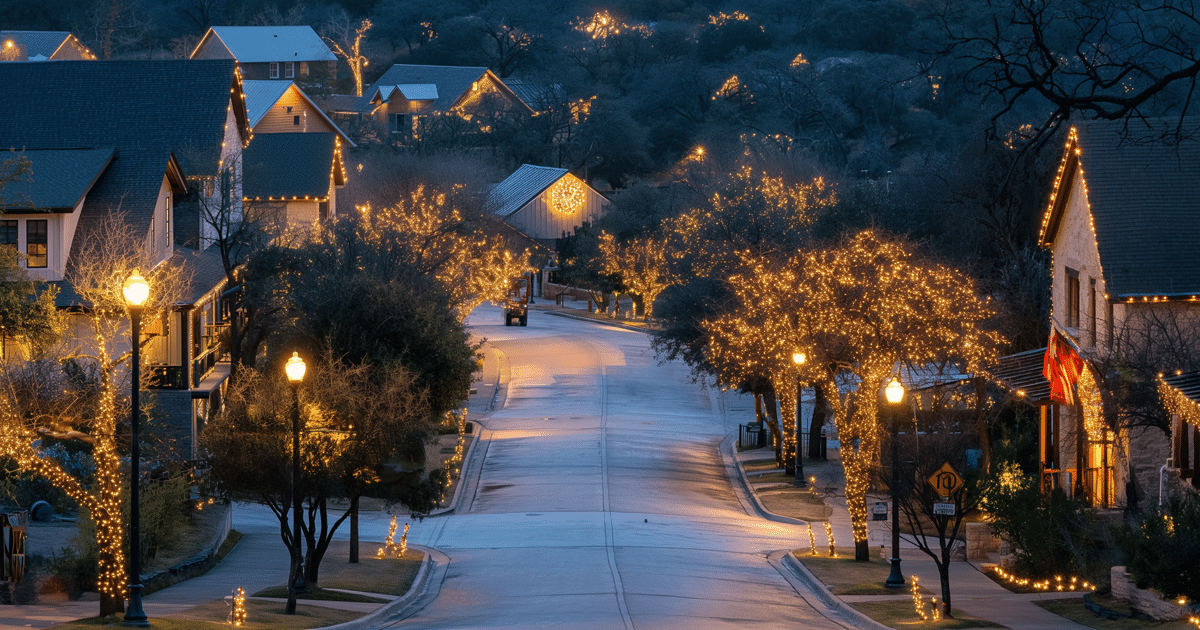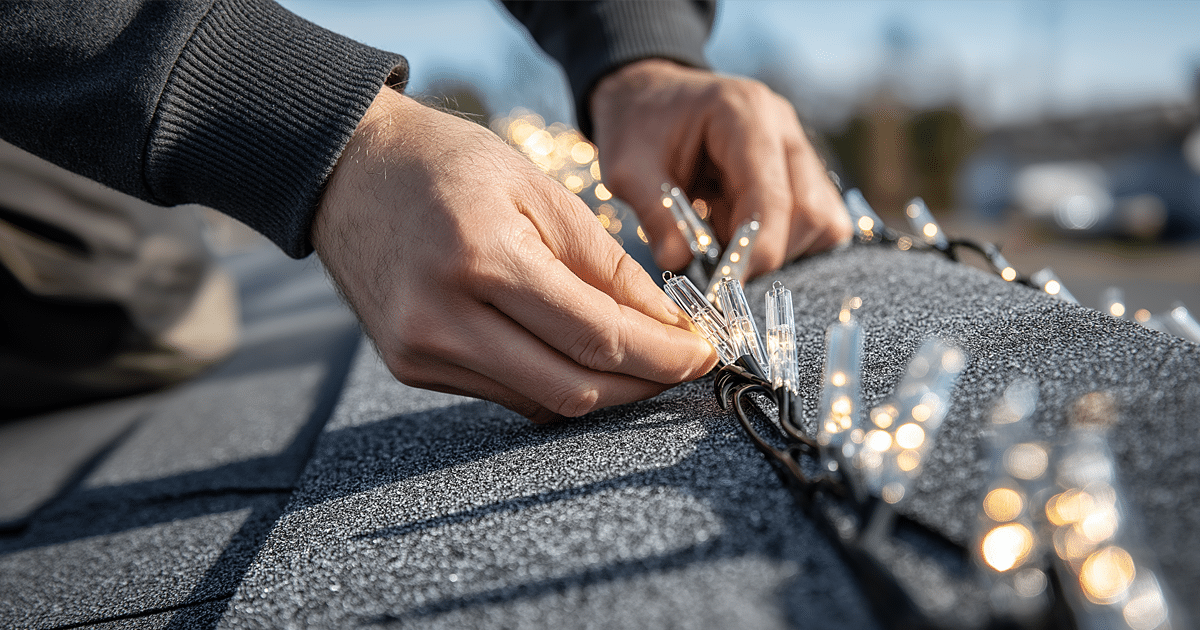Nothing marks the holidays in Central Texas quite like seeing Christmas lights brighten up rooftops, windows, and trees from one house to the next. Those bright displays bring joy, but anyone hanging Christmas lights on a roof knows the process requires caution, planning, and the right equipment. Practicing Christmas Light Hanging Safety on roof surfaces protects your shingles, gutters, and your own safety. Many homeowners don’t notice small holes, cracks, or loose shingles until rain reveals a leak weeks later—proof that installing Christmas lights must be done the right way.
This guide blends practical safety steps with real-world installation techniques so homeowners can stay safe, protect their roof, and create a bright holiday display that stands up to weather, wind, and the Texas holiday season.
Key Takeaways
- Hanging Christmas lights on a roof requires a clear plan and a safe setup. Always inspect shingles, gutters, and roof edges before installing Christmas lights to avoid creating small holes or damaging weak spots.
- Use plastic clips—not nails or staples—to secure decorations. Clips protect the roof surface, prevent leaks, and keep holiday lights in place during wind, rain, and changing weather.
- Practice ladder safety every time you climb. Maintain three points of contact, use a taller ladder if needed, and never lean or slide across a roof to reach lighting.
- Metal roofs, tile roofs, and steep rooflines require special caution. Metal roofs need magnets instead of clips; tile roofs should never be walked on; and steep surfaces may require professional Christmas light installers.
- Keep all extension cords, plugs, and power connections dry and elevated. Outdoor-rated GFCI outlets reduce electrical risk and help holiday lights operate safely throughout the season.
- Check your lighting display after storms, high winds, or heavy rain. Look for shifted clips, loose wiring, or signs that decorations need to be secured again.
- If the job feels risky, hire professional Christmas light installers. Pros have the tools, balance, and equipment to hang roof lights safely and protect your house during the holidays.
Planning and Pre-Hanging Preparations

Start with a simple plan. Walk around your house and look at the roofline: where will holiday lights stand out? Which windows, peaks, or trees deserve attention? Hanging Christmas lights is easier when you know the layout before climbing a ladder. Planning also prevents overloading gutters or placing roof lights where shingles may slide or shift.
Look for loose shingles, lifted nails, or soft spots. These signs can lead to small holes that worsen over time. Installing Christmas lights on damaged surfaces increases roof risk.
Clean Your Gutters
Clogged gutters catch clips, block lights, and hold moisture. Clearing gutters helps roof lights stay secure during rain or high winds.
Map Out the Display
Sketch your Christmas lights design before hanging lights. It keeps the display balanced, visible, and safer.
Metal roofs require magnets instead of plastic clips. Asphalt shingles benefit from slide-under clips. Tile roofs should never be walked on.
Choosing the Right Equipment
Good tools matter. Professional Christmas light installers never rely on nails or staples—they use non-damaging plastic clips, roof-safe hooks, and outdoor-rated extension cords.
- Use Plastic Clips: Plastic clips protect shingles and prevent small holes. They secure decorations without damaging the surface.
- Use a Taller Ladder, if Needed: A taller ladder allows safe access to peaks and prevents accidents caused by overreaching.
- Outdoor-Rated Lights: Choose lights made for weather exposure. Indoor strands can crack or short out.
- Extension Cords: Use outdoor-rated extension cords only. Keep plug connections off the ground.
- LED Lights: LED Christmas lights are bright, durable, and draw less power.
Roof Types and Considerations
Asphalt shingles remain the most common surface for hanging Christmas lights, but they can be damaged easily when homeowners walk improperly or attach clips incorrectly. Slide-under clips are best. Avoid installing Christmas lights on hot shingles, as heat softens asphalt.
Metal roofs are slick—especially in cold weather. Use magnets only. Never walk on wet metal surfaces. Hanging lights on metal roofs requires extra caution.
Tile roofs cannot handle weight. Tile cracks easily. Use a ladder or pole to hang roof lights from the edge instead of walking.
Flat roofs collect water. Keep extension cords elevated and away from low spots.
Ladder Safety and Roof Safety Fundamentals
Most holiday accidents involve ladders. Ladder safety is crucial when homeowners are climbing to hang Christmas lights.
- Maintain three points of contact at all times.
- Wear shoes with traction.
- Place the ladder on level ground.
- Avoid sliding or leaning beyond your center of gravity.
Roof safety overlaps ladder safety. Never walk on frost, rain-soaked shingles, or slick metal surfaces. Secure decorations only when conditions are dry.
Securing the Lights and Using Clips Correctly

Once you begin hanging lights, use plastic clips instead of nails. Nails create holes that lead to leaks. Plastic clips grip without penetrating shingles.
Even spacing keeps lights straight and reduces strain. Too much weight in one section can damage gutters or roof trim.
Avoid overloading circuits. Many light sets specify maximum connections—usually three. Exceeding limits increases fire risk.
Electrical Safety for Holiday Lighting
Electrical safety matters as much as roof safety. Use GFCI outlets outdoors. Keep plug connections protected from rain. Extension cords must be rated for outdoor conditions and inspected for wear.
Avoid daisy-chaining multiple cords. Overloading power sources can cause outages or electrical accidents.
Weather and Environmental Factors
Texas weather changes quickly during the holidays. High winds, sudden rain, and early morning frost all impact holiday lights.
- High winds can rip clips loose.
- Rain increases shock risk.
- Weather fluctuations stress shingles and plastic clips.
Check your display after storms. Look for loose wires or signs of shifting.
Creative Design Ideas and Outline Techniques
Beautiful displays don’t require risky installation. Highlight windows, trees, and pathways to create depth without walking across your roof. Use single-row roof lights for a classic look. Outline peaks and gutters for symmetry.
Use magnets for metal roofs and stick to plastic clips elsewhere. Consistent color temperature helps your display look complete and visible from the street.
Post-Installation Inspection and Maintenance
After hanging Christmas lights, inspect each clip, cord, and anchor point. Seasonal maintenance keeps the display safe.
- Look for sagging.
- Check for exposed wires.
- Make sure clips haven’t shifted after high winds.
- Maintain your lights weekly.
When the season ends, remove lights carefully. Don’t pull strands; doing so can loosen shingles or damage gutters. Coil cords gently. Store lights away from moisture.
Wrapping Up: Stay Safe and Protect Your Roof
Hanging Christmas lights brings joy and tradition. With planning, proper tools, and smart ladder safety, homeowners can stay safe and protect their roof. The holiday season should be bright—not stressful. Using plastic clips, magnets for metal roofs, and avoiding nails prevents damage that might otherwise go unnoticed until rain reveals it.
Whether you’re putting up roof lights on a metal, shingle, or tile surface, following safety steps ensures your house shines all season. If the job feels risky, professional Christmas light installers can complete the project safely. Their equipment, balance, and experience lead to better results and fewer accidents.
Your roof matters. Your safety matters. With the right plan, equipment, and caution, installing Christmas lights becomes a tradition you can enjoy year after year.
Frequently Asked Questions About Hanging Christmas Lights Safely on Your Roof
Can Christmas lights damage my roof?
They can—but only if you use nails, staples, or anything that pierces the roofing surface. Using plastic clips, magnetic hooks (for metal roofs), or gutter clips keeps your roof safe and prevents shingle punctures or granule loss.
What’s the safest way to hang Christmas lights on a metal roof?
Metal roofs should never be drilled or stapled. Magnetic clips, non-marring adhesive hooks, or light-duty clamps work best and protect the finish. They also hold up well in strong Texas winds.
How do I keep lights from sagging or blowing around in the wind?
Even spacing is key. Use clips every 12–18 inches, secure cords so they aren’t loose, and avoid overloading any single section of the roofline. Sagging strands tend to snag gutters or lift during storms.
How many Christmas light strands can I safely connect together?
Most standard LED strands allow up to three connections end-to-end, but always check the manufacturer’s label. Exceeding the rated wattage can overload your outlet or trip a breaker.
What kind of outlet should outdoor Christmas lights plug into?
Always use GFCI-protected outdoor outlets. They immediately cut power if moisture or a wiring fault occurs, which prevents shocks and reduces fire risks.
How do I know if my cords and plugs are safe to use outside?
Look for outdoor-rated cords, intact insulation, and weatherproof plug covers. If a cord feels warm, is cracked, or has exposed wiring, replace it before using it in your display.
Is it safe to walk on my roof while hanging lights?
Only if the surface is dry, stable, and not frosty. Wear shoes with good traction and avoid leaning over edges. If your roof is steep, slick, or high, it’s safer to stay on the ladder or call a professional installer.
Do I need someone with me when hanging lights?
Yes—always. A partner can stabilize the ladder, hand you clips, watch for hazards, and call for help if something goes wrong. Most ladder-related decorating injuries happen when homeowners work alone.
How often should I check my Christmas lights during the season?
A quick weekly walk-through works well. Look for slipped clips, sagging cords, burnt-out bulbs, or damage from wind or rain. Catching small issues early keeps your display safe and tidy.
What’s the safest way to remove Christmas lights after the holidays?
Don’t yank or pull. Remove clips one by one, keeping tension off shingles and gutters. Once the lights are down, coil them gently and store them in a dry container so the insulation doesn’t crack before next season.
Should I replace old incandescent lights with LEDs?
Yes. LED outdoor Christmas lights stay cool, use less power, connect safely in longer runs, and are far more durable in changing weather conditions.
When should I call a professional holiday light installer?
If your roof is steep, tall, metal, slippery, or you’re unsure about ladder work or electrical safety, calling a professional is the best option. Safety comes first—your display should bring joy, not risk.
Contents
- Planning and Pre-Hanging Preparations
- Choosing the Right Equipment
- Roof Types and Considerations
- Ladder Safety and Roof Safety Fundamentals
- Securing the Lights and Using Clips Correctly
- Electrical Safety for Holiday Lighting
- Weather and Environmental Factors
- Creative Design Ideas and Outline Techniques
- Post-Installation Inspection and Maintenance
- Wrapping Up: Stay Safe and Protect Your Roof
- Frequently Asked Questions About Hanging Christmas Lights Safely on Your Roof



